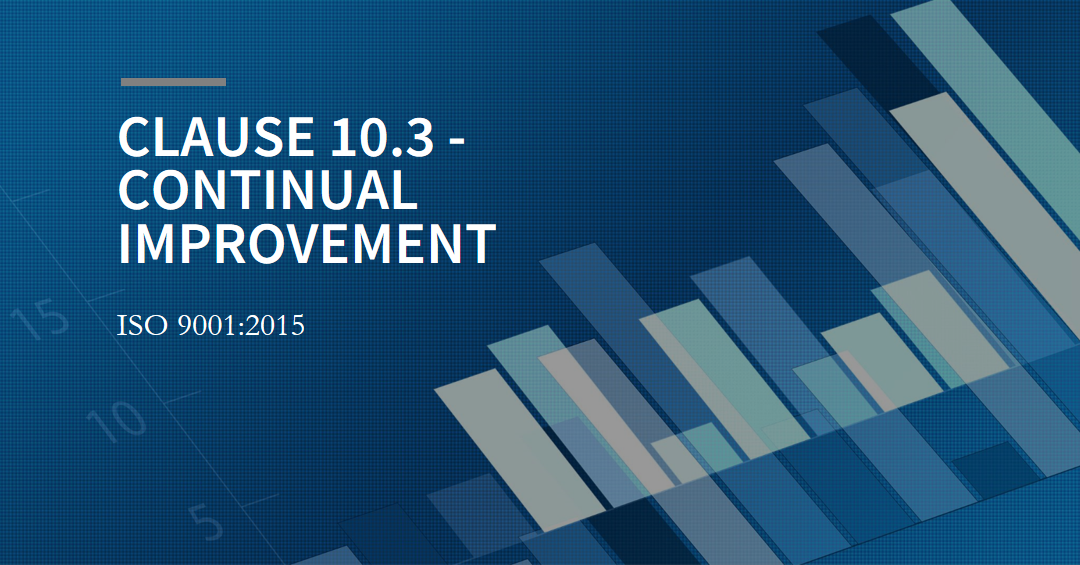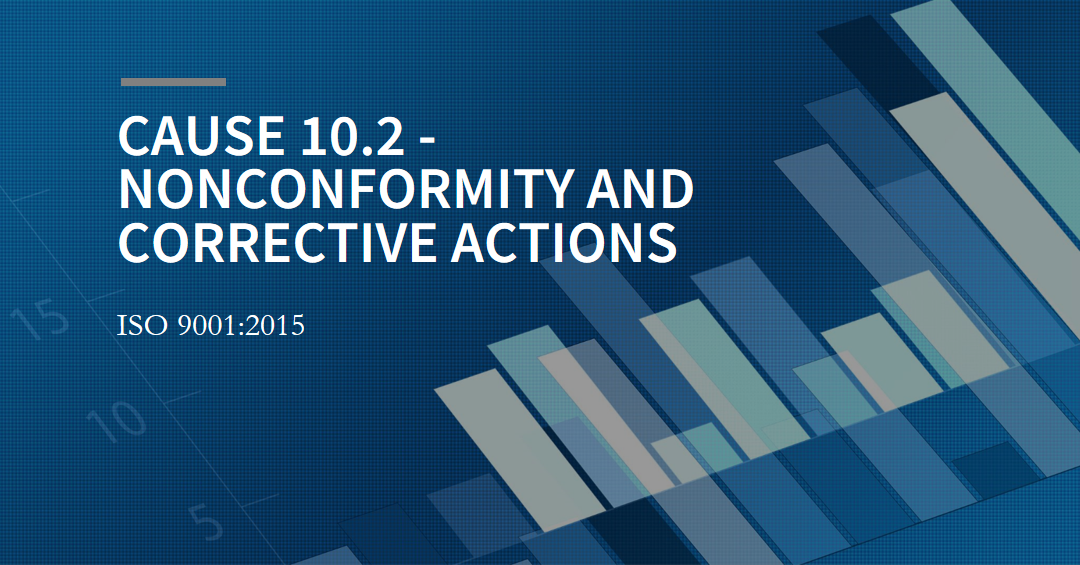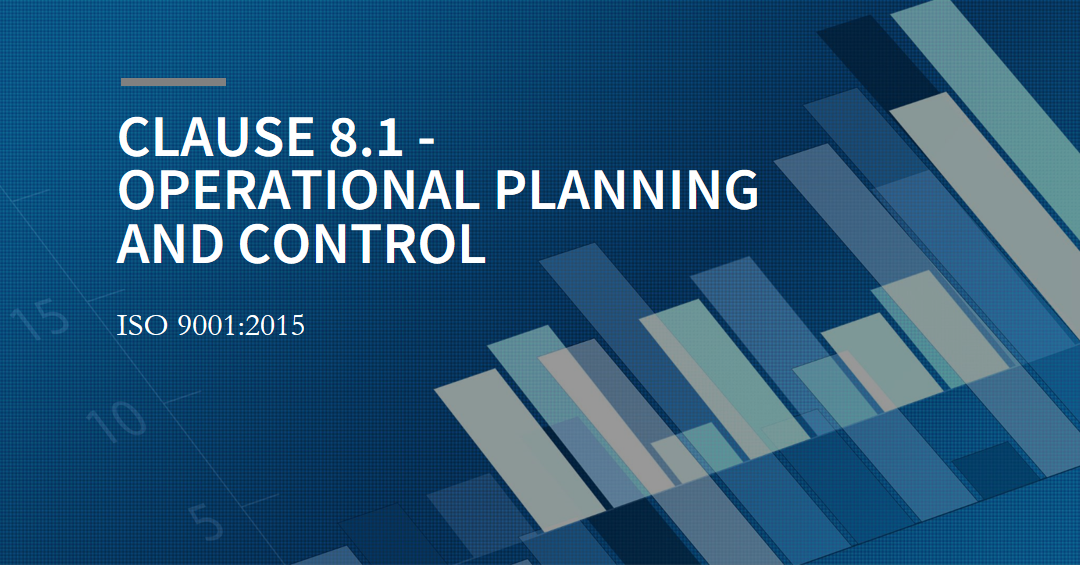
Introduction
Quality management is an essential aspect of any successful business, ensuring consistent delivery of products and services that meet customer expectations. The ISO 9001:2015 standard sets out the criteria for a quality management system and is based on several quality management principles, including a strong customer focus, the involvement of high-level company management, a process approach, and continuous improvement. One of the key elements of this standard is Clause 6.1 - Risk-Based Thinking, which requires organizations to assess and address the risks and opportunities that can affect the conformity of products and services.
This blog post aims to delve into the depths of Clause 6.1, explaining its significance within the ISO 9001:2015 framework and providing actionable insights into how businesses can effectively implement risk-based thinking. By the end of this post, you'll have a comprehensive understanding of Clause 6.1 and how it can be used to enhance your quality management system.
Why is Clause 6.1 critical for your organization? By introducing a proactive approach to identifying and mitigating risks, companies can ensure greater consistency in their operations, leading to improved customer satisfaction and business performance. Let's explore this integral component of ISO 9001:2015 and learn how to apply it effectively.
What is Risk-Based Thinking?
Risk-based thinking is a methodical approach to identifying, analyzing, and addressing potential risks in an organization's processes. It's a proactive stance, aiming to anticipate and mitigate risks before they can impact the business negatively. This approach is central to ISO 9001:2015, which emphasizes preventing undesirable outcomes as much as achieving desired results.
Key Aspects of Risk-Based Thinking:
- Proactivity: Identifying potential risks before they manifest as actual issues.
- Integration: Embedding risk assessment into everyday business practices.
- Efficiency: Focusing on risks that could have significant impacts and prioritizing them accordingly.
Risk-based thinking is not about eliminating all risk but managing it effectively. It requires an understanding that while all business activities carry some level of risk, these risks can be managed, minimized, or even turned into opportunities.
The Shift from Preventive Action to Risk-Based Thinking
ISO 9001:2015 marked a change from the reactive approach of "preventive action" to the proactive stance of "risk-based thinking". The previous versions of the standard emphasized taking action to prevent problems, whereas the current version encourages organizations to anticipate and plan for potential challenges.
Clause 6.1 - Risk-Based Thinking in ISO 9001:2015 Explained
Clause 6.1 specifically addresses actions to address risks and opportunities within the Quality Management System (QMS). It plays a pivotal role in the ISO framework, as it requires organizations to systematically address risks that can affect the conformity of products and services.
Breakdown of Clause 6.1 Requirements:
- Identify the Risks: Organizations must pinpoint risks and opportunities that can affect product or service conformity.
- Analyze the Risks: After identification, the risks must be assessed in terms of severity and likelihood.
- Plan Responses: Develop actions to tackle these risks, integrate them into the QMS, and evaluate their effectiveness.
The clause integrates risk-based thinking into the Plan-Do-Check-Act (PDCA) cycle, promoting continual improvement throughout the organization.
Integrating Risk-Based Thinking with PDCA:
- Plan: Establish objectives and processes necessary to deliver results in accordance with the expected output.
- Do: Implement the processes as planned.
- Check: Monitor and measure processes against policies, objectives, and requirements, and report results.
- Act: Take actions to continually improve process performance.
By incorporating risk-based thinking into this cycle, organizations can ensure that risk management is a dynamic and ongoing process.
The Importance of Implementing Clause 6.1
Implementing Clause 6.1 of ISO 9001:2015 is not just a requirement for certification; it's a strategic approach that can lead to significant benefits for any organization. By focusing on potential risks and opportunities, businesses can ensure stability and sustainability in their operations.
Benefits of Risk-Based Thinking for Organizations:
- Enhanced Decision Making: By understanding potential risks, decision-makers can take proactive steps to avoid or mitigate them.
- Increased Efficiency: Identifying risks early on helps prevent waste of time and resources on less impactful issues.
- Improved Customer Satisfaction: Delivering consistent, high-quality products reduces complaints and boosts customer loyalty.
- Competitive Advantage: A robust risk management process can lead to innovation and improved performance, setting a company apart from its competitors.
How Clause 6.1 Enhances Quality Management Systems:
- Systematic Approach: It introduces a structured method for identifying and managing risks.
- Flexibility: The clause doesn't prescribe a one-size-fits-all approach, allowing businesses to tailor their risk management process.
- Ongoing Improvement: By revisiting and revising risk management activities, companies can continuously enhance their QMS.
Examples of Risk-Based Thinking in Action:
- A manufacturing firm conducts regular risk assessments to identify any potential equipment failures that could halt production, implementing preventive maintenance schedules to mitigate these risks.
- A software company uses risk-based thinking to anticipate and address security vulnerabilities, ensuring the protection of customer data and maintaining trust.
Steps to Apply Clause 6.1 in Your Quality Management System
Applying Clause 6.1 involves a series of steps that organizations can follow to ensure they are effectively managing risks within their QMS.
Identifying Risks and Opportunities
Begin by brainstorming potential risks and opportunities that could impact your processes or objectives. Engage various stakeholders to get a comprehensive view of all possible scenarios.
Assessing and Prioritizing Risks
Once identified, assess the severity and likelihood of each risk. This can help prioritize which risks need immediate attention and which can be monitored over time.
Planning Actions to Address Risks
Develop plans to address each risk. This could include implementing new processes, training, or even redesigning products or services.
Integrating Risk-Based Thinking into Organizational Processes
Ensure that risk management is not a standalone activity but integrated into all business processes. This could involve updating procedures, policies, and objectives to include risk considerations.
Key Points to Remember:
- Document: Keep a record of all identified risks, assessments, and actions taken.
- Communicate: Ensure that all relevant parties are aware of the risks and the measures in place to manage them.
- Review: Regularly review and update the risk management plan to reflect changes in the organization or its environment.
By following these steps, organizations can embed risk-based thinking into their culture and operations, making it a natural part of their everyday activities.
Tools and Techniques for Risk Assessment
Implementing effective risk assessment in your quality management system requires the use of various tools and techniques. These tools help in the identification, analysis, and mitigation of risks consistent with the requirements of Clause 6.1 in ISO 9001:2015.
SWOT Analysis (Strengths, Weaknesses, Opportunities, Threats)
A SWOT analysis can help organizations categorize internal and external factors that could impact their objectives.
- Strengths: Internal attributes that support achieving objectives.
- Weaknesses: Internal attributes that challenge the achievement of objectives.
- Opportunities: External conditions that could be advantageous.
- Threats: External conditions that could cause problems.
Failure Mode and Effects Analysis (FMEA)
FMEA is a step-by-step approach for identifying all possible failures in a design, manufacturing or assembly process, or a product or service.
- Failure Modes: What might go wrong?
- Effects Analysis: What would be the consequences of each failure?
- Causes Analysis: How can the failure occur?
Risk Heat Maps
Risk heat maps are visual tools used to communicate the results of a risk assessment process. They plot the likelihood of risks occurring against the potential impact, helping prioritize risk management activities.
Creating a Risk Heat Map:
- Identify Risks: List the risks identified during the assessment phase.
- Assess Impact and Likelihood: Evaluate each risk for its severity and the probability of occurrence.
- Plot on the Map: Place each risk on the heat map based on its assessed impact and likelihood.
- Analyze: Use the heat map to determine which risks require immediate attention.
Each of these tools can be used individually or in combination to provide a robust analysis of risks, fulfilling the requirements of Clause 6.1 and ensuring a thorough integration of risk-based thinking into the quality management process.
Overcoming Challenges with Risk-Based Thinking
While risk-based thinking provides many benefits, it can also present challenges, especially during initial implementation. Understanding these challenges is critical to developing strategies to overcome them.
Common Misconceptions About Clause 6.1
- Overcomplication: Some believe risk-based thinking requires complex processes, when, in fact, it can be scaled to fit the organization's size and context.
- Only for Large Organizations: Small businesses can also benefit greatly from risk-based thinking, not just large corporations.
Addressing Resistance to Change in Organizations
Change can be difficult, and introducing a new way of thinking about risks may meet with resistance. To overcome this:
- Educate: Provide training to help staff understand the value of risk-based thinking.
- Involve: Engage employees in the risk identification and assessment process.
- Lead by Example: Management should demonstrate their commitment to risk-based thinking.
Strategies for Effective Risk Management
- Clear Communication: Ensure that everyone in the organization understands their role in managing risks.
- Regular Reviews: Schedule regular reviews of the risk management process to keep it relevant and effective.
- Continual Improvement: Foster an environment where feedback is encouraged, and opportunities for improvement are acted upon.
By recognizing the potential challenges and misconceptions about Clause 6.1, organizations can better prepare and equip themselves to integrate risk-based thinking successfully into their quality management systems.
Case Studies: Success Stories of Implementing Clause 6.1
Exploring real-world applications of Clause 6.1 in ISO 9001:2015 can provide valuable insights into the practical benefits of risk-based thinking. Here, we will examine a couple of case studies that demonstrate the successful implementation of this clause.
Case Study 1: Manufacturing Industry
Situation: A mid-sized manufacturing company was facing frequent production delays due to machinery breakdowns, which led to missed deadlines and customer dissatisfaction.
Action: They decided to apply Clause 6.1 by conducting a thorough risk assessment of their production line using FMEA. They identified critical machines that had the highest risk of failure and implemented a preventative maintenance schedule.
Result: The frequency of breakdowns reduced significantly, leading to more reliable production schedules and improved customer satisfaction. The company also saw a decrease in maintenance costs due to fewer emergency repairs.
Case Study 2: IT Services
Situation: An IT service provider recognized the risk of data breaches and system downtime, which could compromise client data and trust.
Action: They embraced Clause 6.1 by performing a SWOT analysis and risk heat mapping to evaluate their cybersecurity stance. They prioritized risks and developed an incident response plan.
Result: The IT firm improved its security measures and response times to potential threats, ensuring better protection of client data and enhancing their market reputation.
Lessons Learned:
- Proactive risk assessment can prevent costly disruptions.
- Involving employees in risk management fosters a culture of continuous improvement.
- Regularly updating risk management plans is vital to adapt to new risks.
Monitoring and Reviewing Risks
Continuous monitoring and periodic reviewing of risks are essential components of an effective risk management process as outlined in Clause 6.1.
Ongoing Risk Monitoring Strategies
- Real-time Dashboards: Implement dashboards to provide a live view of key risk indicators.
- Regular Audits: Conduct internal audits to assess the effectiveness of risk management actions.
- Employee Feedback: Encourage employees to report potential risks they perceive in their daily activities.
The Role of Internal Audits in Risk-Based Thinking
Internal audits are a powerful tool for evaluating the effectiveness of the risk management process. They can identify areas where risks are not adequately addressed and where improvements can be made.
Reviewing and Updating the Risk Management Plan
- Schedule Regular Reviews: Establish a routine for reviewing and updating the risk management plan.
- Document Changes: Keep a detailed record of any changes made to the risk management process.
- Assess Effectiveness: After implementing changes, assess their effectiveness in managing risks.
Regular monitoring and reviewing ensure that the risk management process remains dynamic and responsive to both internal and external changes that could impact the organization.
Integrating Clause 6.1 with Other ISO Standards
Clause 6.1 is not only applicable to ISO 9001:2015 but can also be aligned with other ISO standards to create a comprehensive management system.
Synergy with ISO 14001 – Environmental Management
Risk-based thinking can be applied to environmental aspects, helping organizations prevent or reduce undesired impacts on the environment.
Aligning with ISO 45001 – Occupational Health and Safety
Implementing Clause 6.1 in conjunction with ISO 45001 can help organizations proactively manage workplace risks, enhancing employee safety and well-being.
Integrating Multiple ISO Standards:
- Unified Approach: Create a common framework for managing risks across different aspects of the business.
- Consistent Documentation: Ensure documentation processes are aligned across ISO standards.
- Integrated Training: Train employees on the integrated management system to foster a unified understanding of risk management.
By integrating Clause 6.1 across various ISO standards, organizations can streamline their management processes, reduce duplication of effort, and enhance overall performance.
Preparing for ISO 9001:2015 Certification
Achieving certification to ISO 9001:2015 demonstrates an organization's commitment to quality and continuous improvement. Clause 6.1 plays a critical role in this process. Here's how to prepare for certification with a focus on risk-based thinking.
Steps to Ensure Compliance with Clause 6.1
- Conduct a Gap Analysis: Determine where your current QMS stands in relation to the requirements of Clause 6.1.
- Develop a Risk Management Framework: Based on the gap analysis, establish or refine your risk management processes.
- Implement Necessary Changes: Apply the framework and make any necessary changes to your QMS.
Documentation and Evidence of Risk-Based Thinking
- Risk Management Policy: Create a policy that defines how risk is managed within the organization.
- Risk Register: Maintain a register that lists identified risks, their assessments, and mitigation actions.
- Audit Reports: Keep records of audit reports that show how risks are being monitored and managed.
Tips for a Successful ISO 9001:2015 Audit
- Be Prepared: Ensure all employees are aware of the procedures and their roles in risk management.
- Be Thorough: Have all documentation ready and easily accessible for the auditor.
- Be Open: Be ready to discuss how the organization plans to address any identified risks or opportunities.
Preparing for ISO 9001:2015 certification involves more than just meeting the standards; it's about embedding quality and risk management into the fabric of the organization.
Conclusion
Clause 6.1 - Risk-Based Thinking is a cornerstone of the ISO 9001:2015 standard. By incorporating this proactive approach, organizations can enhance their quality management systems, reduce the potential for negative outcomes, and capitalize on opportunities that arise. While the implementation of risk-based thinking can come with challenges, the benefits it brings to process efficiency, decision making, and customer satisfaction make it a valuable investment.
Remember, risk-based thinking is not a one-time event but a continuous, dynamic process that requires ongoing attention and improvement. Organizations that effectively integrate Clause 6.1 into their operations will be better positioned to adapt to changes and thrive in today's competitive business environment.
Frequently Asked Questions (FAQs)
- What are the key differences between preventive action and risk-based thinking?Preventive action is about correcting issues before they occur, while risk-based thinking involves a broader anticipation and preparation for potential risks and opportunities.
- How often should risk assessments be conducted in an organization?Risk assessments should be conducted at planned intervals and when significant changes occur that could affect the QMS.
















